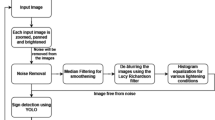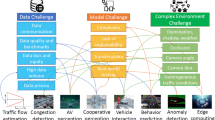Abstract
Improving traffic safety is one of the important goals of Intelligent Transportation Systems (ITS). In vehicle-based safety systems, it is more desirable to prevent an accident than to reduce severity of injuries. Critical traffic problems such as accidents and traffic congestion require the development of new transportation systems. Research in perceptual and human factors assessment is needed for relevant and correct display of this information for maximal road traffic safety as well as optimal driver comfort. One of the solutions to prevent accidents is to provide information on the surrounding environment of the driver. Augmented Reality Head-Up Display (AR-HUD) can facilitate a new form of dialogue between the vehicle and the driver; and enhance ITS by superimposing surrounding traffic information on the users view and keep drivers view on roads. In this paper, we propose a fast deep-learning-based object detection approaches for identifying and recognizing road obstacles types, as well as interpreting and predicting complex traffic situations. A single convolutional neural network predicts region of interest and class probabilities directly from full images in one evaluation. We also investigated potential costs and benefits of using dynamic conformal AR cues in improving driving safety. A new AR-HUD approach to create real-time interactive traffic animations was introduced in terms of types of obstacle, rules for placement and visibility, and projection of these on an in-vehicle display. The novelty of our approach is that both global and local context information are integrated into a unified framework to distinguish the ambiguous detection outcomes, enhance ITS by superimposing surrounding traffic information on the users view and keep drivers view on roads.
















Similar content being viewed by others
References
Accesed 22 may 2014. https://www.nsnam.org/
Akhlaq M (2010) A smart-dashboard: Augmenting safe & smooth driving
Batavia PH, Pomerleau D, Thorpe CE et al (1997) Overtaking vehicle detection using implicit optical flow. In: IEEE conference on intelligent transportation system, 1997. ITSC’97. IEEE, pp 729–734
Behrisch M, Bieker L, Erdmann J, Krajzewicz D (2011) Sumo–simulation of urban mobility. In: The 3rd international conference on advances in system simulation (SIMUL 2011). Barcelona, Spain
Bergenhem C, Coelingh E, Johansson R, Tehrani A (2014) V2v communication quality: measurements in a cooperative automotive platooning application. SAE Int J Passenger Cars Electron Electr Syst 7(2014-01-0302):462–470
Bradai A, Ahmed T, Benslimane A (2014) Vicov: efficient video streaming for cognitive radio vanet. Veh Commun 1(3):105–122
Caird J (2004) In-vehicle intelligent transportation systems. Transportation in an Aging Society, p 236
Cheng HT, Shan H, Zhuang W (2011) Infotainment and road safety service support in vehicular networking: from a communication perspective. Mech Syst Signal Process 25(6):2020–2038
Choi RA (2015) Automatic speed controllable vehicle and method for controlling speed thereof. US Patent 20,150,149,059
Cireṡan D, Meier U, Masci J, Schmidhuber J (2012) Multi-column deep neural network for traffic sign classification. Neural Netw 32:333–338
De Felice M, Cerqueira E, Melo A, Gerla M, Cuomo F, Baiocchi A (2015) A distributed beaconless routing protocol for real-time video dissemination in multimedia vanets. Comput Commun 58:40–52
Donahue J, Jia Y, Vinyals O, Hoffman J, Zhang N, Tzeng E, Darrell T (2013) A deep convolutional activation feature for generic visual recognition. arXiv preprint arXiv:1310.1531
Fang Z, Fei F, Fang Y, Lee C, Xiong N, Shu L, Chen S (2016) Abnormal event detection in crowded scenes based on deep learning. Multi Tools Appl 75(22):14,617–14,639
Fu WT, Gasper J, Kim S (2013) Effects of an in-car augmented reality system on improving safety of younger and older drivers. In: 2013 IEEE international symposium on mixed and augmented reality (ISMAR). IEEE, pp 59–66
Ghoreyshi SM, Shahrabi A, Boutaleb T (2016) A novel cooperative opportunistic routing scheme for underwater sensor networks. Sensors 16(3):297
Girshick R (2015) Fast r-cnn. arXiv preprint arXiv:1504.08083
Girshick R, Donahue J, Darrell T, Malik J (2014) Rich feature hierarchies for accurate object detection and semantic segmentation. In: 2014 IEEE conference on computer vision and pattern recognition (CVPR). IEEE, pp 580–587
Haklay M, Weber P (2008) Openstreetmap: User-generated street maps. IEEE Pers Commun 7(4):12–18
Halit L, Kemeny A, Mohellebi H, Garbaya S, Mérienne F, Michelin S, Albaut V Augmented reality head-up-display for advanced driver assistance system: A driving simulation study
Haloi M (2015) A novel plsa based traffic signs classification system. arXiv preprint arXiv:1503.06643
Han P, Zhao G (2016) Line-based initialization method for mobile augmented reality in aircraft assembly. The Visual Computer, pp 1–12
He K, Zhang X, Ren S, Sun J (2014) Spatial pyramid pooling in deep convolutional networks for visual recognition. In: Computer Vision–ECCV 2014. Springer, pp 346–361
He K, Zhang X, Ren S, Sun J (2016) Deep residual learning for image recognition. In: Proceedings of the IEEE conference on computer vision and pattern recognition, pp 770–778
Huang CM, Lin SY (2014) Cooperative vehicle collision warning system using the vector-based approach with dedicated short range communication data transmission. IET Intell Transp Syst 8(2):124–134
Huang J, Li B, Zhu J, Chen J (2017) Age classification with deep learning face representation. Multimedia Tools and Applications, pp 1–17
Jama M, Risaq A, Issa S, Khalifa OO (2010) Performance evaluation of mpeg-4 video transmission over ieee802. 11e. Int J Comput Netw Secur 2(5):11–15
Jia Y, Shelhamer E, Donahue J, Karayev S, Long J, Girshick R, Guadarrama S, Darrell T (2014) Caffe: Convolutional architecture for fast feature embedding. In: Proceedings of the ACM International Conference on Multimedia, pp 675–678. ACM
Khaleda Y, Tsukadaa M, Santab J, Choia J, Ernsta T (2009) A usage oriented analysis of vehicular networks: from technologies to applications. J Commun 4(5):357–368
Khandelwal SA, Abhale AB, Nagaraj U (2014) Accident prevention and air pollution control using vanet under cloud environment
Kim H (2010) An efficient alert broadcasting scheme considering various densities in vanet. In: Networked digital technologies
Kim S, Dey AK (2009) Simulated augmented reality windshield display as a cognitive mapping aid for elder driver navigation. In: Proceedings of the SIGCHI conference on human factors in computing systems. ACM, pp 133–142
Kim S, Dey AK (2016) Augmenting human senses to improve the user experience in cars: applying augmented reality and haptics approaches to reduce cognitive distances. Multi Tools Appl 75(16):9587–9607
Lee JW, Yoon CR, Kang J, Park BJ, Kim KH (2015) Development of lane-level guidance service in vehicle augmented reality system. In: 2015 17th international conference on advanced communication technology (ICACT). IEEE, pp 263–266
Lenc K, Vedaldi A (2015) R-cnn minus r. arXiv preprint arXiv:1506.06981
Li H, Nashashibi F (2011) Multi-vehicle cooperative perception and augmented reality for driver assistance: a possibility to ’see’through front vehicle. In: 2011 14th international IEEE conference on intelligent transportation systems (ITSC). IEEE, pp 242–247
Liu W, Anguelov D, Erhan D, Szegedy C, Reed S (2015) Ssd: single shot multibox detector. arXiv preprint arXiv:1512.02325
Liu W, Anguelov D, Erhan D, Szegedy C, Reed S, Fu CY, Berg AC (2016) Ssd: single shot multibox detector. In: European conference on computer vision. Springer, pp 21–37
Meng F, Spence C (2015) Tactile warning signals for in-vehicle systems. Accid Anal Prev 75:333–346
Milanés V, Shladover SE, Spring J, Nowakowski C, Kawazoe H, Nakamura M (2014) Cooperative adaptive cruise control in real traffic situations. IEEE Trans Intell Transp Syst 15(1):296–305
Mota S, Ros E, Ortigosa EM, Pelayo FJ (2004) Bio-inspired motion detection for a blind spot overtaking monitor. Int J Robot Autom 19(4):190–196
Moysset B, Adam P, Wolf C, Louradour J (2015) Space displacement localization neural networks to locate origin points of handwritten text lines in historical documents. In: ICDAR 2015 workshop on historical document imaging and processing
Naranjo JE, Gonzalez C, Garcia R, De Pedro T (2008) Lane-change fuzzy control in autonomous vehicles for the overtaking maneuver. IEEE Trans Intell Transp Syst 9(3):438–450
Ng-Thow-Hing V, Bark K, Beckwith L, Tran C, Bhandari R, Sridhar S (2013) User-centered perspectives for automotive augmented reality. In: 2013 IEEE international symposium on mixed and augmented reality-arts, media, and humanities (ISMAR-AMH). IEEE, pp 13–22
Ngai DC, Yung NH (2007) Automated vehicle overtaking based on a multiple-goal reinforcement learning framework. In: Intelligent transportation systems conference, 2007. ITSC 2007. IEEE. IEEE, pp 818–823
Olaverri-Monreal C, Gomes P, Fernandes R, Vieira F, Ferreira M (2010) The see-through system: A vanet-enabled assistant for overtaking maneuvers. In: Intelligent vehicles symposium (IV), 2010 IEEE. IEEE, pp 123–128
Paul B, Ibrahim M, Bikas M, Naser A (2012) Experimental analysis of aodv & dsr over tcp & cbr connections with varying speed and node density in vanet. arXiv preprint arXiv:1204.1206
Redmon J, Divvala S, Girshick R, Farhadi A (2016) You only look once: Unified, real-time object detection. In: Proceedings of the IEEE conference on computer vision and pattern recognition, pp 779–788
Ren S, He K, Girshick R, Sun J (2015) Faster r-cnn: towards real-time object detection with region proposal networks. arXiv preprint arXiv:1506.01497
Ren S, He K, Girshick R, Zhang X, Sun J (2015) Object detection networks on convolutional feature maps. arXiv preprint arXiv:1504.06066
Rezende C (2014) Video streaming in vehicular ad hoc networks: challenges, protocols and the use of redundancy. Ph.D. thesis, University of Ottawa
Richter P Ar-hud – technology for a dialog without words. http://www.continental-corporation.com/www/pressportal.comen/themepressreleases/3automotivegroup/interior/pressreleasespr20140721arhudtechniken.html
Schall MC, Rusch ML, Lee JD, Dawson JD, Thomas G, Aksan N, Rizzo M (2012) Augmented reality cues and elderly driver hazard perception. Human Factors: The Journal of the Human Factors and Ergonomics Society p pp. 0018720812462029
Schofield K (2013) Driver assistance system for a vehicle. US Patent App. 13/919,483
Sermanet P, LeCun Y (2011) Traffic sign recognition with multi-scale convolutional networks. In: The 2011 international joint conference on neural networks (IJCNN). IEEE, pp 2809–2813
Silvéria M.K. (2014) Virtual windshields: merging reality and digital content to improve the driving experience. arXiv preprint arXiv:1405.0910
Sivaraman S, Trivedi MM (2014) Dynamic probabilistic drivability maps for lane change and merge driver assistance. IEEE Trans Intell Transp Syst 15(5):2063–2073
Stallkamp J, Schlipsing M, Salmen J, Igel C (2011) The german traffic sign recognition benchmark: a multi-class classification competition. In: The 2011 international joint conference on neural networks (IJCNN). IEEE, pp 1453–1460
Stallkamp J, Schlipsing M, Salmen J, Igel C (2012) Man vs. computer: Benchmarking machine learning algorithms for traffic sign recognition. Neural Netw 32:323–332
Stebbins MA, Kiefer RJ (2014) Vehicle seat back haptic alert systems and methods. US Patent App. 14/453,391
Tian D, Zhou J, Wang Y, Zhang G, Xia H (2016) An adaptive vehicular epidemic routing method based on attractor selection model. Ad Hoc Netw 36:465–481
Timofte R Kul belgium traffic signs and classification benchmark datasets. http://btsd.ethz.ch/shareddata
Tonnis M, Sandor C, Lange C, Bubb H (2005) Experimental evaluation of an augmented reality visualization for directing a car driver’s attention. In: Proceedings of the 4th IEEE/ACM international symposium on mixed and augmented reality. IEEE Computer Society, pp 56–59
Wang F, Yang M, Yang R (2009) Conflict-probability-estimation-based overtaking for intelligent vehicles. IEEE Trans Intell Transp Syst 10(2):366–370
Werneke J, Vollrath M (2012) What does the driver look at? The influence of intersection characteristics on attention allocation and driving behavior. Accid Anal Prev 45:610–619
Xie H, Boukerche A, Loureiro A Mervs: A novel multi-channel error recovery video streaming scheme for vehicle ad-hoc networks
Yang J, Xu R, Cui J, Ding Z (2016) Robust visual tracking using adaptive local appearance model for smart transportation. Mult Tools Appl 75(24):17,487–17,500
Zaklouta F, Stanciulescu B, Hamdoun O (2011) Traffic sign classification using kd trees and random forests. In: The 2011 international joint conference on neural networks (IJCNN). IEEE, pp 2151–2155
Author information
Authors and Affiliations
Corresponding author
Rights and permissions
About this article
Cite this article
Abdi, L., Meddeb, A. Driver information system: a combination of augmented reality, deep learning and vehicular Ad-hoc networks. Multimed Tools Appl 77, 14673–14703 (2018). https://doi.org/10.1007/s11042-017-5054-6
Received:
Revised:
Accepted:
Published:
Issue Date:
DOI: https://doi.org/10.1007/s11042-017-5054-6




